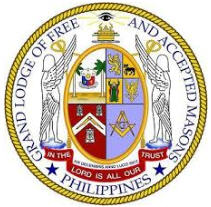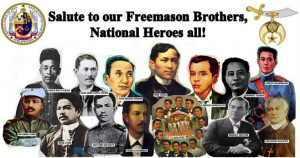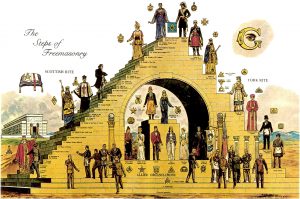 The Most Worshipful Grand Lodge of Free and Accepted Masons of the Philippines
The Most Worshipful Grand Lodge of Free and Accepted Masons of the Philippines
In 1912, there were established in the Philippines three American Lodges owing allegiance to the Most Worshipful Grand Lodge of California. They were Manila Lodge No. 342, Cavite Lodge No. 350 and Corregidor Lodge No. 386. The Grand Lodge of Scotland had two – Lodge Perla del Oriente No. 1034 and Cebu Lodge No. 1106. 
On November 17, 1912, by virtue of a resolution addressed to each of these three American Lodges, a meeting at 10 o’clock in the morning was held for the purpose of organizing a Grand Lodge of the Philippines. Perla del Oriente No. 1034 and Cebu Lodge No. 1106, S. C. were invited but for some reason failed to attend.
The purpose of the meeting was to discuss the necessary preliminary steps leading to the first Convention of the delegates from the different Lodges for the organization of a Grand Lodge of Free and Accepted Masons for the Philippine Islands and to fix the date for holding the convention. It was then unanimously decided to hold the First Convention for the organization of the Grand Lodge on December 11, 1912 at 8 o’clock in the evening in the Masonic Temple, Manila, Philippine Islands.
(None of the Filipino Lodges were invited to send representatives to the convention that formed the Grand Lodge because the leaders of the convention felt sure that the presence of such representatives would be looked upon by the Grand Lodges in the United States generally and by that of California in particular as irregular and would give them sufficient reason to deny recognition to the new Grand Lodge. The primary concern of the convention was to proceed in accordance with the Masonic principles and procedures that guided the formation of the various Grand Lodges in the United States. The reason for the organization of the Grand Lodge was that “such a step would assure the permanency and promote the progress and efficiency of the legitimate and Ancient Craft Masonry in the Philippines.”)
On December 11, 1912 at 8:30 PM, the Convention assembled at the Masonic Temple, Manila wherein the representatives of the several Lodges of Free and Accepted Masons present, after compliance of the necessary requisites in accordance with precedence already established, proceeded in the establishment of a Grand Lodge for the Philippine Islands.
At 8:00 PM on December 18, 1912, at the Masonic Temple, Manila, with Bro. George R. Harvey, P.M., presiding, the Convention resolved itself into a Committee and presented a completed Constitution which was subsequently approved by the brethren.
Following this and in compliance with a provisional article, a Lodge of Master Masons was opened for the purpose of organizing and opening in Masonic form, the Grand Lodge of Free and Accepted Masons of the Philippine Islands. An election for Grand Lodge Officers was then held and the result are as follows:
- Bro. H. Eugene Stafford – MW Grand Master
- Bro. George H. Harvey – RW Deputy Grand Master
- Bro. Burton Whitecomb – RW Senior Grand Warden
- Bro. Charles J. Kindler – RW Junior Grand Warden
- Bro. Joseph F. Bromfield – VW Grand Treasurer
- Bro. Amos G. Bellis – VW Grand Secretary
- Bro. Newton C. Comfort – VW Grand Lecturer
They then proceed to the installation of the officers-elect. Bro. Luther A. Renner, P.M. of Manila Lodge No. 342 acted as Installing Officer. The Grand Master-elect, after his installation by Bro. Renner, announced the appointment of the following brethren to fill the various other offices:
- Bro. Guy Clinton – VW Grand Chaplain
- Bro. Charles C. Cohn – Grand Orator
- Bro. William F. Wichman – Grand Marshal
- Bro. Luther A. Renner – Sr. Grand Deacon
- Bro. Louis C. O’Donnel – Jr. Grand Deacon
- Bro. Emmanuel Valmas – Grand Tyler
The Lodge of Master Masons was then closed in ancient Masonic form. The Convention having completed the business for which it had been assembled, was adjourned at 12:45 AM December 19, 1912. The first Communication of the Grand Lodge of Free and Accepted Masons of the Philippine Islands was held in the Masonic Temple at 1:00 AM of the same date.

The Filipino Lodges felt that the American Lodges had not acted with true Masonic spirit in not inviting to the Convention Lodges working under the Grand Oriente Español. The reason such an invitation was not extended was because most members of Lodges holding Charters from California agreed that it would be considered irregular by many of the Grand Lodges of the United States, which would neither take the time nor show interest enough to investigate the reasons for such action. They would simply have refused to grant recognition to the new Grand Lodge for allowing irregular Lodges to participate in its deliberations.
Therefore, the greatest care had to be taken in all conversations preliminary to a fusion. Like Latin-Americans and all other peoples influenced by Spanish culture, the Filipino is sensitive, and his feelings are easily hurt.
This situation was well understood by Americans who had made a careful study of the problem, and who had more or less personal contacts with influential members of the Regional Grand Lodge who were devoted to the cause of Masonry. Such Americans fully sympathized with the Filipinos’ feelings and attitude. They well knew that the history of the Filipino Mason was one of which any body of Masons would be proud. While Lodges in many countries had only matters of detail to annoy them, many members of the Philippine Lodges had suffered, bled and even died to uphold the principles of the Fraternity. Most Worshipful Bro. Newton C. Comfort, P.G.M. expressed the feelings of All-American Masons in the following words taken from our Proceedings of 1917:
“ We who have not had to suffer for our Masonry are not fully cognizant of its sweetness as those whose Masonic history includes the sacrifice of the lives of brethren, the suppression of their Lodges, the prohibition of the use of the name, the struggle for Light in the darkness, and the most selection of members, lest one enter who could not be implicitly trusted and who would deliver the Mason to be executed – these are the fires of purification which has sanctified the Fraternity here and resulted in the formation of a Masonry sublime, glorified.

“ As time passed it seemed more and more imperative that if we were to accomplish the greatest good of which we were capable, Masonry in these far flung Isles must present a solid front before the world. To use an over-worked expression, it really seemed as if the psychological moment had arrived for bringing all the Lodges working under the various jurisdictions into our Grand Lodge. For well we knew the sincerity and love for the Fraternity which had been shown by the brethren in the Lodges working under foreign Grand Bodies. Some, yea, many of whom had suffered, bled and even died solely and simply because they were members of our Fraternity.”
From the very organization of the Grand Lodge of the Philippine Islands, tentative advances were made from time to time to the Lodges of the Regional Grand Lodge in an endeavor to find a common ground in which a union might be brought about. In 1916 it was clearly realized that unless such a fusion took place in the immediate future the two groups would drift farther apart and a union eventually become impossible. This naturally would result in the utmost discord and confusion and defeat the very purpose, which are inherent in the establishment of Masonic Lodges in any community. There was as great a diversity of opinion as to the desirability of this union among the members of the various Lodges which composed the Grand Lodge of the Philippine Islands as there was among the various members of the Lodges which composed the Regional Grand Lodge. In fact, steps had gone so far in that body that they had obtained the consent from the Gran Oriente Español to form their own independent Grand Lodge in the Philippines.
A Committee of three was appointed composed of Most Worshipful Brother Harry Eugene Stafford, the first Grand Master; Most Worshipful Brother Newton C. Comfort, the Second Grand Master and Most Worshipful Brother William H. Taylor, the incumbent Grand Master, to see what could be done to bring about the fusion. This Committee met with a similar Committee appointed by the Grand Master of the Regional Grand Lodge upon the request of Brother Taylor, composed of Worshipful Brothers Manuel L. Quezon, Teodoro M. Kalaw and Tomas Earnshaw, and a tentative plan for the fusion was drawn up.
Thanks to the heroic efforts of Most Worshipful Brother Quezon, the steps that we disliked to insist upon but which we deemed most necessary, were taken. Application for dispensation of the various Lodges composing the Regional Grand Lodge were duly received by the Grand Lodge of the Philippine Islands in regular session assembled, referred to the Committee on Charters, and on the recommendation of this Committee, Charters were ordered granted to the respective Lodges so applying for dispensation. On the next day, Wednesday, February 14, 1917, the Grand Lodge met and the following twenty-seven Lodges, formerly composing the Regional Grand Lodge, were constituted and their officers installed:
Nilad No. 12; Walana No. 13; Dalisay No. 14; Pilar No. 15; Sinukuan No. 16; Bagong Buhay No. 17; Araw No. 18; Silanganan No. 19; Rizal Lopez No. 20; Dapitan No. 21; Rizal Manila No. 22 Solidaridad No. 23; Banahaw No. 24; Malinao No. 25; Pinagsabitan No. 26; Bagumbayan No. 27; Balintawak No. 28; Zapote No. 29; Mactan No. 30; Magdalo No. 31; Martires No. 32; Isarog No. 33; Lincoln No. 34; Batangas No. 35; La Regeneracion No. 36; Kalilayan No. 37; Bulusan No. 38.
While the question as to whether the fusion should take place was being debated on the floor of the Grand Lodge of the Philippine Islands, it was clearly realized by the members composing that Grand Lodge that immediately upon the reception of the Regional Grand Lodge, insomuch as they greatly outnumbered the Lodges then composing the Grand Lodge, that the control would ipso facto pass into the hands of the new members of the Lodge. Some of those who had doubtless the best interest of the Grand Lodge at heart, but were not so farsighted as the majority of their brethren, suggested that the election of the Grand Officers for the ensuing year be held before the admission of the new members, thus prolonging for one year the control in the hands of those whom they thought would have the best interest of the Grand Lodge at heart.
In their shortsightedness they failed to see that had their opinion prevailed, the confidence which the fusion was supposed to create would at its inception have been destroyed, and the purpose of the fusion nullified. For no body of men could maintain their self respect if they had submitted tamely to any such question of their fealty to the principles of the organization for which they and their forebears had suffered so much to perpetuate in the Philippines. We consider that the fusion which was brought about and consummated by those farseeing Masons of both Grand Lodges, was the most momentous and important Masonic event which has taken place in the history of Masonry since the fusion of two Grand Lodges in England in 1813.
Brother Taylor who was Grand Master of our Grand Lodge at the time these events took place has been asked over the years what were the mechanics employed in taking in the Filipino Lodges to form our present Grand Lodges? In Brother Taylor’s words, I hereby quote:
 “ The steps which we, as constituent Masons of the Grand Lodge, considered as absolutely essential were just those which seemed to our Filipino Brethren most unnecessary, in that they considered themselves, and justifiably so, as good Masons as any in the world. The conditions laid down were, that for each Lodge to be admitted the Master and Wardens of that Lodge were to kneel at the Altar and take the obligations of the three degrees of Masonry. I conferred those obligations, and I have never felt a more serious and inspired feeling in a Masonic Lodge than I did in looking into those serious upturned faces, knowing they were making a sacrifice of their own personal feelings and prejudices for what they considered the good of Masonry in the Philippines.
“ The steps which we, as constituent Masons of the Grand Lodge, considered as absolutely essential were just those which seemed to our Filipino Brethren most unnecessary, in that they considered themselves, and justifiably so, as good Masons as any in the world. The conditions laid down were, that for each Lodge to be admitted the Master and Wardens of that Lodge were to kneel at the Altar and take the obligations of the three degrees of Masonry. I conferred those obligations, and I have never felt a more serious and inspired feeling in a Masonic Lodge than I did in looking into those serious upturned faces, knowing they were making a sacrifice of their own personal feelings and prejudices for what they considered the good of Masonry in the Philippines.
“ All other business of the Grand Lodge having been transacted previous to the acceptance of the new Lodges, the next and final order of business was the election of the Grand Officers for the ensuing Masonic year. It was my duty to explain just what the mechanics of the operation were, who were entitled to vote, and gave a demonstration as an illustration of just how the voting was done.
“Outside of the Filipino leaders, none of the rank and file of the Filipino Masons had realized that with the fusion the control of the Grand Lodge would pass into their hands. In short, to bring about the fusion no point was stressed to get the Filipino to agree to the fusion, but that it was for the good of Freemasonry in the Philippines. When during the example of how the voting would be conducted, and it gradually dawned on them that the control was in their hands, such an expression of amazement, wonderment and incredibility passed over their faces as I never expect to have the pleasure of seeing again.
“When I saw the modus operandi was thoroughly understood, I ordered the election to proceed. Knowing that they had the control and that Brother Quezon was due the greatest credit for having brought the fusion to a successful conclusion I naturally thought that they would select him for the first Grand Master of the united Grand Lodge, and though this matter had never been touched upon in our many conferences, it was presumed by the American Lodges that such would be the case, and with this selection we were in hearty accord. Imagine my astonishment when the Filipino Lodges began to cast their votes. They were unanimous for me as their Grand Master. I was so astonished I did not know what to do. Most Worshipful Brother George R. Harvey was sitting at my left and I turned to him and said in bewilderment, ‘Judge, what shall I do?’ And I remember how he smiled that characteristic smile of his and replied ‘What can you do?’ Worshipful Brother Quezon was elected Deputy Grand Master. After the meeting was adjourned, I hastened to Brother Quezon to assure him of my entire innocence and ignorance of what had taken place and why. He laughed his hearty laugh and said: ‘It’s just what those Filipinos wanted and I am so happy that they did.’ He continued – ‘Since you Americans have acted so magnanimously in giving the control into our hands, you and I will make a gentleman’s agreement, so long as you and I have any influence in Philippine Masonry there shall be a rotation in the office of Grand Master. You are Grand Master this year, I am to be the next, and thereafter each American holder of the office will be followed by a Filipino Grand Master.”
Long after the influence of both Brother Taylor and Brother Quezon had ceased in matters concerning the Grand Lodge, that gentleman’s agreement held. It was not until 1974 that the last American Grand Master was elected.
From this acorn planted by the Grand Lodge of California and watered by Manila Lodge No. 1 over the years, has grown the mighty oak of the Grand Lodge of the Philippines.